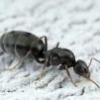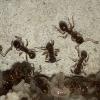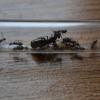I gave my Lasius colony their first small drop of raw honey! I put it in and 20 minutes later half the colony is out trying to get a fresh drink. This was super strange as they are usually very timid and only a couple workers forage and return food at a time. It may be due to the fact that it was right near their nest entrance but maybe they just enjoy it that much!
Edited by Pumpkin_Loves_Ants, October 20 2019 - 12:40 PM.




















